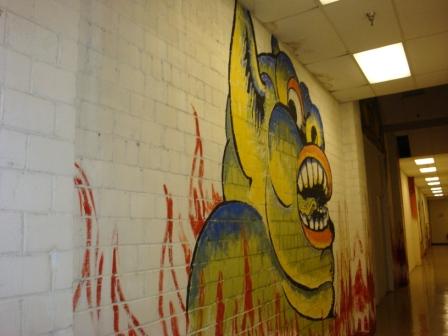We baby boomers grew up in a time when many televised movies were westerns or World War II films. I also loved Hogan Heroes, the television series about allied POWs who were operating an espionage unit within Stalag 13, a POW camp run by bumbling Germans. Yet, it was not until 2010 that I learned that the allies had POW camps here in America.
Although over 400,000 WWII POWs were in America. The camps were small and scattered across the country. Last year, I had the opportunity to visit Wright-Patterson AFB near Dayton, and that is where I first learned about not only all the German POWs, but also the ones held at what was then known as Wright Field.
These prisoners worked on the base in base mess halls and warehouses, as well as maintaining the grounds. Apparently, since some of them had artistic abilities, they painted several murals on mess hall walls depicting German folklore. Evidence indicates that the German POWs painted three murals, yet only one remains today – standing quietly in an unsuspecting building as a part of the base’s history. I’m glad I got to see them, otherwise I may have never known about WWII POWs in America – even those not all that far away.



Prisoners were held all over the US and Canada, primarily due to fear of them escaping out of England, and for sheer sake of room. Two small but significant problems cropped up. The first was due to the Geneva convention, which states that prisoners must be held in conditions similar to where they were captured. The idea was to keep from “torturing” warm-climate prisoners by encamping them in frigid climes and vice versa. The problem came with the surrender of the Afrika Korps at the end of the North African campaign. The US set up prison camps in Texas to hold them, but the Germans are from cooler climes, especially those from the north of Germany. and the inmates were miserable. They complained, but the US stuck by the convention – though they did provide a lot of comforts like ice cream, which was virtually unknown to front-line German troops ANYWHERE!
The other problem was, again, in the south. Segregation was common in the South, so blacks couldn’t go into movie theatres and restaurants, but the German and Italian prisoners were taken out of camps to do work in the towns, and were allowed to go into these businesses. Needless to say, this caused a GREAT deal of tension with the black soldiers, who were refused entry even in uniform.
Escapes were rare. but a few did occur. Canada had a large number of U-boat crews, who were the most fervent escape artists. Especially by the end of the Sicilian campaign in 1943, many German soldiers were so war weary, and were treated so well, that many camps had minimal perimeter fences and few guards!
Thanks, Frank, for throwing one my way! 😉
LikeLike
By the by, Frank, where on base is that mural? I’ve been all around both the museum and the annexes, including the restoration building, but haven’t gone further in. Thanks!
LikeLike
John,
Museum and annex visitors do not have access to this area. I would think that many museum visitors don’t realize that the base has another area several miles away.
LikeLike
John,
And I knew I could count on you for more to the story. Thanks for sharing.
LikeLike
I had no idea about this. Thanks, I learned something today!
LikeLike
Nancy,
Me too … thus seeing this touched me. Thanks for reading.
LikeLike
A great post with a little history thrown in.
LikeLike
Don,
Glad you enjoy it … and many thanks for stopping by.
LikeLike
Just a quick note to add that was not mention about the Murals. Above the false ceiling are a lot more murals. I came across these when I worked at the base as a maintenance worker in the 1980’s. They actually scare the heck out of me when I pointed the light at them! Will never forget that.
LikeLike
Rodger,
Welcome first-time visitor … and wow … thanks for sharing that interesting information!!!
LikeLike
Pingback: Flashbacks: A Potpourri | A Frank Angle
Fascinating history. What happened after the war?
LikeLike